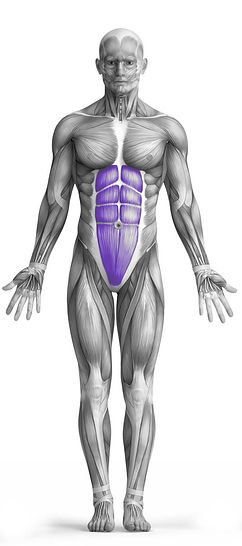Hollow-Body Rock 101 Video Tutorial
0

Exercise Synopsis
Target Muscle Group
Abs
Secondary Targets
Execution
Compound
Force Type
Core
Required Equipment
Bodyweight
Fitness Level
Intermediate
Variations
None
Alternatives
Timer
Hour
Minute
Second
Stopwatch
00:00:00:00
Overview
The Hollow-Body Rock is an effective bodyweight exercise designed to strengthen the abs while also engaging the hip flexors, lower back, quadriceps, and shoulders. To perform the exercise, lie on your back and lift your legs and shoulders off the floor, keeping your lower back pressed against the ground. Maintain this hollow-body position and gently rock back and forth, focusing on keeping your core tight and stable. This dynamic movement enhances core strength, improves overall body stability, and helps develop endurance in the secondary muscle groups involved.
How to Perform
Initial Position: Lie flat on your back with your arms extended towards the ceiling, aligning them with your ears. Ensure your shoulder blades are lifted off the floor.
Leg Lift: Press your lower back into the ground and lift your legs 3 to 6 inches above the floor, keeping your toes pointed.
Engage Muscles: Tightly squeeze your legs, arms, and abs to create tension and maintain the hollow-body shape.
Rocking Motion: Gently rock back and forth while holding the hollow-body position. Focus on keeping your core engaged and maintaining the arch created by your legs and arms.
Maintain Tension: Keep your abs engaged throughout the movement to stabilize your core and prevent any loss of form.
Repetition: Continue the rocking motion for as many repetitions as you can while ensuring proper form and consistent muscle engagement.
★ Bonus: For exercises that involve external weights (such as dumbbells, barbells, or machines), the One Rep Max (1RM) calculator can help you estimate your maximum lifting capacity. Use it to track your strength progress and adjust your training for optimal results.
Tips
Start by lying flat on your back with your arms extended towards the ceiling and shoulder blades lifted off the floor.
Lift your legs 3 to 6 inches off the ground while pressing your lower back into the floor.
Keep your toes pointed and legs straight throughout the exercise.
Engage your core, legs, and arms to maintain a tight hollow-body position.
Rock gently back and forth while ensuring that the hollow-body shape is preserved.
Avoid letting your lower back arch away from the floor or legs drop too low.
Keep your abs consistently engaged to stabilize the core and enhance effectiveness.
Maintain smooth, controlled movements to prevent excessive strain on the lower back.
Focus on steady breathing while performing the exercise to maintain endurance.
Ensure proper form and alignment to maximize core activation and prevent injury.
How Not to Perform
Avoid Arching Your Lower Back: Do not let your lower back lift off the floor. This can cause lower back strain and reduce the effectiveness of the exercise on the abs.
Don’t Drop Legs Too Low: Avoid letting your legs fall below the recommended height. Dropping too low can increase the strain on your lower back and reduce core engagement.
Neglecting Core Engagement: Do not relax your abdominal muscles. Failing to keep your core tight can lead to poor form and decrease the exercise’s effectiveness.
Incorrect Arm Position: Avoid letting your arms move away from your ears or dropping them. Keep them extended and aligned to maintain the hollow-body position.
Excessive Rocking: Do not rock too aggressively or with large motions. Small, controlled movements are more effective and safer for maintaining proper form.
Poor Leg Position: Avoid bending your knees or pointing your toes incorrectly. Keep your legs straight and toes pointed to maintain proper alignment and effectiveness.
Holding Breath: Do not hold your breath during the exercise. Breathe steadily to maintain core tension and prevent dizziness.
Inconsistent Form: Avoid breaking the hollow-body shape. Ensure your body remains in the correct position to maximize engagement and prevent injury.
Overarching Shoulders: Do not let your shoulders hunch up towards your ears. Keep them down and away from your ears to maintain stability and proper form.
Neglecting Smooth Motion: Avoid jerky or rapid movements. Controlled rocking helps maintain the exercise’s effectiveness and reduces the risk of injury.
Variations
Variations of fitness exercises refer to different ways of performing a specific exercise or movement to target various muscle groups, intensities, or goals. These variations aim to challenge the body differently, prevent plateaus, and cater to individuals with varying fitness levels.
Alternatives
Alternative exercises in fitness refer to different movements or activities that target similar muscle groups or serve the same training purpose as the primary exercise. These alternative exercises can be used as substitutes when the original exercise is unavailable or challenging to perform due to various reasons such as equipment limitations, injuries, or personal preferences.








